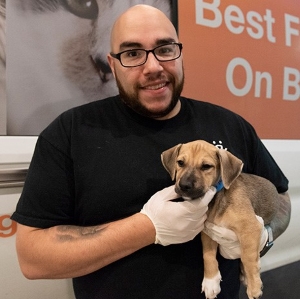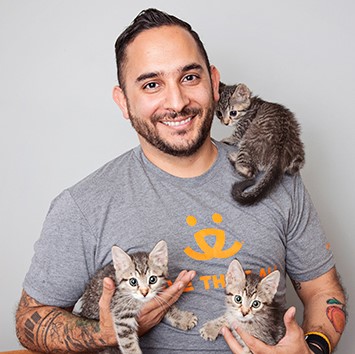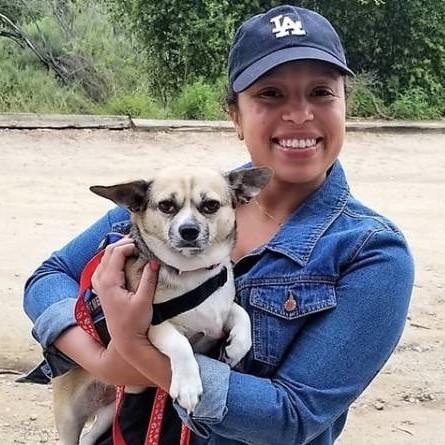Danielle Applestone: In the summer of 2017, Cathy and Bella were happy and content in Houston’s Oak Forest neighborhood. Cathy White’s a licensed acupuncturist, Bella is an Anatolian shepherd and Great Pyrenees mix. Cathy knew the breed well and understood why not everyone had the soft spot for them that she did.
Cathy White: I got Bella from a goat farm out in Columbus, which is about 100 miles away from here. They’re very frequently used as livestock guardian dogs, but occasionally they will go rogue and start eating the livestock that they’re supposed to be guarding and so they put the dogs in rescue. Oh yeah, a lot of people just shoot the dogs. Some of them just dump them and then put them in rescue.
Danielle Applestone: Bella had a very different issue. Her owner had found her to be too friendly. In mid-August, she was adopted by Cathy’s family. A week after that all hell broke loose. Hurricane Harvey made landfall with 130-mile-an-hour winds. It produced 52 tornadoes and dumped a trillion gallons of water on Houston in four days.
Cathy White: You know, things started raining and lightning and Bella was barking and I’m like, “Well, let’s just get out of here.” You have six million people leaving off of the six freeways, that’s a lot of traffic.
Danielle Applestone: And a lot of stress, which was about to get worse.
Cathy White: Because we were in traffic for a while, so then I stopped. She just had a leash and collar on and she slipped the collar and took off. It was one of the most awful experiences ever to know that she’s off by herself and terrified. It sucked really bad.
Danielle Applestone: The crisis within a crisis left White helpless. When the storm finally passed, FEMA dispensed emergency supplies and an organization called Best Friends Animal Society, a non-profit animal welfare organization, was also mobilizing. Using makeshift facilities from existing shelters to airline hangers, Best Friends utilized hotspots and mobile workstations to reunite animals separated from their owners. After weeks of searching local shelters, White got word – a dog matching Bella’s description was being housed at Houston’s NRG Arena. It’s not the sort of work Best Friends spends most of its time doing, but it has to rank among the most rewarding.
Danielle Applestone: Stories of the familial bonds between humans and animals are old as folklore. Yet today, technology plays a growing role, not just in happy reunions, but as an invaluable tool to America’s animal welfare workers. I’m Danielle Applestone, engineer and entrepreneur, and my favorite pet was a red Chow named Max. This is Technology Powers X. In this episode, technology powers a better world for animals.
Danielle Applestone: The bond between humans and pets, let’s start with dogs, predates written history, and while the relationship has changed little over tens of thousands of years, our ability to care for animals is transforming quickly. Natural disasters, storms, tornadoes, earthquakes, separate humans from animals, creating urgent needs for reunion and adoption. For an organization such as Best Friends Animal Society, a key to fast, effective mobilization is data, which begins with an understanding of regional trends in pet ownership. Michael Bricker is director of operations for the Shelter Embed program at Best Friends.
Michael Bricker: We do see more pets per people per capita in the South than more of the northern states. In the northern states, where it gets cold, you don’t have animals that stay outside all year round, but in southern states you do, so that lets people have dogs outside plus inside, indoor and outdoor cats. I think everybody in Texas seems to have multiple pets. In New Jersey, I had four dogs and that was like, man, people were like, “Four dogs? You have four dogs?” But here, four dogs is like the base amount. Most of my employees have four plus pets in their house. I do think that whether it plays a part in that as well.
Danielle Applestone: The work of Best Friends is also rooted in an understanding of national numbers and social forces that directly affect pet ownership. Many pet owners have to move or have landlords with a no-pets policy. Financial hardship, life changes and divorce, all contribute to animal displacement. The deeper Best Friends became engaged in data, the more it could pinpoint specific needs among animal welfare providers, needs which vary considerably from state to state.
Michael Bricker: Best Friends has done a lot of research into the country. We’ve pulled a lot of data from all of the shelters across the country, or as many as we could get data from, and we’ve seen that there’s definitely priority states. Most of them are southern states, California is number one, Texas number two. What we find when we go into some of these shelters, that when we dig down even deeper into the state and we figure out what shelters within that state are our highest priorities, we find out that most of the issues are the same, it’s lack of resources. Maybe one shelter that we’ll go into, there’s not a lot of veterinary support around, then we have another shelter that we’ll go to and it’s a leadership issue.
Danielle Applestone: What the team encountered is a web of animal welfare Services doing their best to cope, but also being slow to evolve. Marc Peralta is Chief Programs Officer for Best Friends.
Marc Peralta: When I got into animal welfare, which was 15 years ago, our shelter pretty much ran very similarly to shelters from the ’80s, ’70s, ’60s. What I mean by that is it was kind of like a collection dish of animals, and you have this many kennels, this is how many animals you had. You did adoption programs and processes, but we didn’t really trust the community very well as a movement. We had special applications for specific animals. It’s a century-old traditional way of running a business that didn’t evolve that much, and that’s the biggest issue.
Danielle Applestone: Best Friends was born when the digital age was in its infancy. It was 1984, when, with few resources, a group of like-minded friends set about building an animal sanctuary in southern Utah. No board leadership, no strategic plan, but their goal then, as now, is unchanged.
Marc Peralta: And what that means in our world is really it’s the work on the ground. The work with partners all over the country, there’s over 3,000 network partners, which are either shelters or rescue groups that are working to save every adoptable animal in shelters across the country.
Marc Peralta: The Best Friend’s mission, in just a couple of sentences, is to end the killing of dogs and cats in America’s shelters. I think what that means is there are animals that are euthanized in shelters, which that’s usually sick and injured and that is the right thing to do, but there is a huge subset of animals, the majority of animals still that enter animal shelters that end up not getting out that are healthy and treatable. All of our work is to end the killing of animals, those animals that are saveable.
Danielle Applestone: What helps drive the team is a combination of the right attitude and tools that simply didn’t exist a few years back.
Marc Peralta: It’s really just hard to get people to believe, so a lot of my work is almost being an evangelist for technology, for different ways of doing things, challenging things that we’ve always thought were false being true and vice versa. It’s definitely still a lot of heavy lifting in certain areas, but the thing that keeps me going is I remember what it was like 15 years ago in this field. I’ve seen how much it grows, and that kind of stuff I make sure it doesn’t fall short in my mind when I have really tough days, because most of the time our work is with the areas that need the heaviest lifting in regards to life saving and changing the way that they’re doing things. But we have so many success stories, it makes it a little bit easier to continue to stay positive. We are positive, and we’re a positive organization.
Danielle Applestone: Peralta is seeing a professionalization of the animal welfare sector, which, until recently, had been lacking. The Shelter Embed program Michael Bricker mentioned has been a big part of that change. Like a reality show that helps a struggling business, members of the Best Friends team embed themselves in an animal welfare organization that’s struggling and that wants to change, providing facts, data, and technology strategies to help turn things around. Bricker recalls the case of the Palm Valley Animal Shelter in Edinburg, Texas.
Michael Bricker: The building was built in the ’70s and really nothing has been changed since. Anything that could go against the shelter was going against this shelter in particular, but the thing I was most worried about was the staff. I could figure out a building, I can figure out funding, I can figure out programming, but if the staff didn’t want to make those changes, there’s nothing that I could do by myself obviously. You need a team, you need a large team to make these changes happen, but when I got there, I very quickly found out that this staff wanted this way more than I could have ever imagined. They wanted to save lives. They were sick and tired of trying their hardest and not being able to move the needle. It took a little while. I think they thought I was a little nutty when I first got there, like, “Who is this guy from New Jersey telling us about these things and these changes he wants to make?”
Danielle Applestone: It soon became clear that while pep talks would not win the staff over, data would. The Shelter Embed team went to work at what Bricker calls collecting wins.
Michael Bricker: I think we were able to show them that through data. Instead of just saying we are saving more lives, I was able to show them. I was able to show them with reports that we were pulling from PetPoint and the amount of adoptions that we did more this year than last year and how many more animals we were saving over the amount that we unfortunately couldn’t save the year prior. We were able to see all those wins back to back and the staff just rallied behind it. Once they saw this ship start moving, they all jumped on. It was amazing.
Danielle Applestone: It was at that shelter in Edinburg that Bricker orchestrated a technology win for pit bulls.
Michael Bricker: One of the number one things that I got that they wanted to change was our policy, Palm Valley’s policy, on not adopting pit bulls out to the community. Palm Valley’s board, at the time, created a ban on the adoption of pit bulls. It wasn’t because they were bad people, they didn’t have all the information. Once I was able to get in front of the board, I created a presentation. I talked about how pit bulls are just like any other dog, it’s crazy to have a ban on them. I gave them information and data to support those facts. When presented with the information they voted unanimously for us to adopt out pit bulls, but I think the staff seeing that, that they were heard, that I understood that they really wanted to change that policy and I made that one of the first things that I really fought to do and then we were able to complete that, I think that really got a lot of the staff on board pretty quickly.
Danielle Applestone: Among the bigger challenges for Best Friends is teaching the public to unlearn what it thinks it knows about animals. Community cats, for instance. Marc Peralta.
Marc Peralta: Community cats are cats that are not used to … They’re not your cat that’s sitting on the couch, watching The Masked Singer with you. They’re used to being outdoors. Sometimes they’re friendly, sometimes they don’t know what to do around humans.
Danielle Applestone: Empowered with the right information and the right tools, Best Friends is constantly embracing new efficiencies.
Marc Peralta: Because oftentimes we spend so much time trying to find information that we want to pass on to somebody or spreadsheets that we’ve created or those kinds of things, and we’re learning to be smarter and utilizing better technology or new technology to organize ourselves a little bit more, spend less time on doing those kind of things and gives us more time to actually go and help animals.
Danielle Applestone: Having data and mobility have become a lifeline for the Best Friends team.
Marc Peralta: We wouldn’t be able to do any of the work that we do without the actual hardware as well. We all have Dell laptops and we take them on our trips, they are with us in our homes, they are with us in our offices, to ensure that whatever we’re doing and what we’re doing at Best Friends here for animals, we couldn’t do it without those laptops.
Danielle Applestone: The efficiencies Best Friends finds often extend to removing barriers to pet adoption, such as simplifying the online adoption process.
Morgan Saunders: I decided to initially foster a dog at the beginning of quarantine.
Danielle Applestone: True, Morgan Saunders didn’t mean to adopt a dog. Not at first, anyway.
Morgan Saunders: I was like, “I have some extra time on my hands. I can foster a dog,” no intention on adopting. Then I was connected with Best Friends-LA, I was matched with Sugar and decided I wanted to take on this challenge.
Danielle Applestone: And the next thing she knew …
Morgan Saunders: Maybe about a month and a half into the fostering process, they called me and they were like, “Oh, we’re going to put Sugar up on the adoption website.” I was like, “Wait, what? No, I don’t want her to be adopted. I want her, I want her. I want to adopt her,” and they were like, “That’s great news.”
Danielle Applestone: Best Friends had identified the process and the paperwork as a barrier to pet adoption, so the process is being streamlined through the use of technology, with stacks of forms giving way to person-to-person interviews.
Morgan Saunders: When I think of shelters, I think of antiquated systems and processes and whatnot, but the whole process was pretty straightforward, pretty intuitive. We did a Microsoft Teams call for the first sit down where I was being interviewed to see if I would be a good foster mom. Then when I decided that I wanted to adopt her, I had another conversation with the vet at the time that she was saying, just to make sure everything was above board and that I didn’t fall in love with a dog who was sick or needed a lot of medical attention that I wasn’t aware of or would run into issues after adopting her.
Danielle Applestone: No, technology isn’t the hero in this story, though it’s becoming an indispensable means of empowering those working to rescue animals, uniting and reuniting them with owners. Michael Bricker.
Michael Bricker: Being able to know about everybody in my shelter with a click of the button is extremely important. Also, technology helps us reunite people and their pets. We’re able to post pictures on social media. These pictures that we put in our animal management system go automatically to our website so people can find their pets. Microchips are a big piece of technology that has helped reunite tons of animals and their pets. If the animal has a microchip, we scan it, we look it up, we give a call and the person can come and reclaim their pet. We let them know they’re here right away. There’s a ton of ways that technology works for us every single day and it solves countless amounts of problems.
Danielle Applestone: And for Best Friends, every problem solved means more animals saved.
Danielle Applestone: This is Technology Powers X, an original podcast from Dell Technologies. For more information on Dell Latitude laptops and 2-in-1s, please visit DellTechnologies.com/Latitude. To learn more about this episode, our speakers, and to read the transcript, visit DellTechnologies.com/TechnologyPowersX. I’m Danielle Applestone, thanks for listening.
 Dell Solutions with Intel®
Dell Solutions with Intel® Michael Bricker
Director of Operations for the Shelter Embed program, Best Friends Animal Society
Michael Bricker
Director of Operations for the Shelter Embed program, Best Friends Animal Society
 Marc Peralta
Chief Programs Officer, Best Friends Animal Society
Marc Peralta
Chief Programs Officer, Best Friends Animal Society
 Morgan Saunders
Adopter of Sugar, a Chihuahua mix
Morgan Saunders
Adopter of Sugar, a Chihuahua mix
